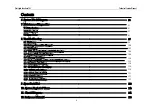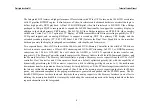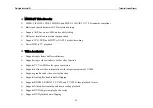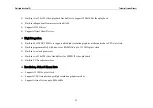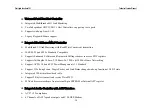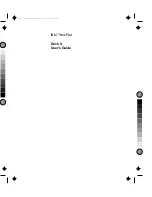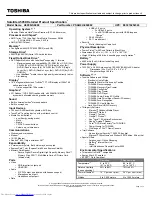
4
Prestigio Cavaliere 141
Technical Service Manual
The ICS 1893 is a low-power, physical-layer device (PHY) that supports the 10Base-T and 100Base-TX Ethernet
standards. This VLSI device is designed for easy implementation of 10/100 Mb/s Fast Ethernet LANs. It interfaces
to a MAC through an MII interface ensuring interoperability between products from different vendors.
The ENE CB1410 CARDBUS controller supports one PCMCIA or CARDBUS interface.
The NS PC87393 Super I/O controller integrates the standard PC I/O functions: LPC bus interface, X-Bus Extension
for read and write operations, floppy disk interface and one EPP/ECP capable parallel port. Like all LPC Super I/O
devices, the PC87393 offers a single-chip solution to the most commonly used PC I/O peripherals to provide for the
increasing number of multimedia applications, the AC97 CODEC ALC201 is integrated onto the motherboard which
contain 3D audio output.
SiS301LV, which is an accompany chip of SiS VGA chip, integrates: (1) A NTSC/PAL video encoder with
Macrovision Ver.7.1.L1 option for TV display, (2) A LVDS transmitter with bi-linear scaling capability for TFT
LCD panel display. SiS301LV receives digital video signals and control signals from the primary VGA chip then
transforms them into composite, S or component video outputs for TV display, LVDS signals for LCD display.
The H8/3437 is a high performance microcontroller with a fast H8/300 CPU core and a set of on-chip supporting
functions optimized for embedded control. These include ROM, RAM, four types of timers, a serial communication
interface, optional I²C bus interface, host interface, A/D converter, D/A converter, I/O ports, and other functions
needed in control system configurations, so that compact, high performance systems can be implemented easily.
A full set of software drivers and utilities are available to allow advanced operating systems such as Windows ME,
Windows 2000 and Windows XP to take full advantage of the hardware capabilities. Features such as bus mastering
IDE, Plug and Play, Advanced Power Management (APM) with application restart, software-controlled power
shutdown.
Following chapters will have more detail description for each individual sub-systems and functions.



